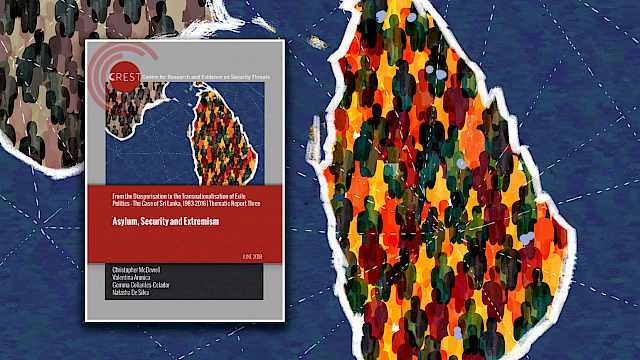Executive summary
The evidence base informing countering violent extremism (CVE) interventions is limited. However, there has been an increase in empirical research exploring the design and delivery of interventions in recent years. These studies are complemented by a growing body of research analysing processes of engagement in, and disengagement from, violent extremism which can help inform interventions. This report reviews the key themes emerging from these two related literatures over the past 12 months, as well as lessons drawn from international case studies. These themes are:
- The use of former extremists in interventions and radicalisation research
- The social ecology of interventions
- Community reporting
- Online interventions
- Intervention practice: lessons from international case studies
- Emerging research agendas: gendered approaches to intervention; idiosyncratic and emerging ideologies; and the impact of COVID-19 on counter-terrorism and CVE practice
In exploring these themes, this report outlines a series of implications for policy and practice in relation to secondary and tertiary CVE interventions and identifies key evidence gaps. The effectiveness of CVE interventions remains poorly understood and publicly available research that draws on the experiences of those receiving support from interventions is sparse. However, several important findings can be drawn from this literature, alongside recommendations for those working in this area.
Key findings
Former extremists are increasingly being used to deliver offline and online interventions, but the effectiveness of these interventions remains poorly understood.
Interviews with formers reinforce existing knowledge about the push and pull factors that contribute to engagement in, and disengagement from, extremism. Recent research has drawn attention to key drivers of disengagement including disillusionment with extremist movements and social-ecological factors such as the availability of alternative social networks.
Disillusionment can be driven by a variety of factors including a sense of frustration with the group’s leadership or their lack of progress in achieving stated goals; burnout; the group no longer meeting the ‘core need’ (such as a search for identity) that motivated initial engagement; and concerns about the use of violence against civilians or other group members.
Insights from formers highlight the importance of social-ecological and contextual factors. In the absence of pro-social relationships with family members or friends outside of the movement, individuals, even those who are disillusioned, are less likely to disengage.
Multi-disciplinary interventions that target a range of social-ecological factors are increasingly being used around the world to support those at risk of being radicalised and to facilitate disengagement and deradicalisation and have produced some promising early results.
Communities can be willing to support efforts to prevent and counter violent extremism and to make referrals, but they need to be supported to do so effectively. Some countries are pursuing efforts to use interventions to build community resilience so that communities can more effectively support individuals who may be at risk of being radicalised.
There is some evidence that online interventions can be effective, but this evidence base is very limited. More research is needed to understand the opportunities and limitations of the online space, particularly in the context of the COVID-19 pandemic.
Counter-messaging campaigns are more effective at influencing some audiences than others. A recent systematic review suggested that counter-narratives might be effective at tackling the early stages of radicalisation, but less able to challenge the views of those who support violence.
Determining the effectiveness of different interventions remains difficult based on the available evidence. However, UK and international case studies reinforce the idea that best practice involves offering tailored multi-agency interventions that are designed to address the specific individual and ecological risk factors identified in individual cases.
Practice-based challenges remain, including the difficulty of standardising how risk is assessed, and in ensuring multi-agency coordination.
Several promising research agendas have begun to emerge around gendered approaches to interventions; idiosyncratic ideologies; and the potential impact of the COVID-19 pandemic on CVE. However, the evidence base underpinning this research is limited.
Recommendations for intervention design and delivery
Working with and learning from formers
It is important to understand the background and position of someone with a history of violent extremism to interpret their potential role in interventions. Considerations when engaging formers in this work include their likely credibility in the eyes of the target audience; the extent to which they have specialist knowledge of the specific ideology or movement that the intervention is focused on; the potential emotional or physical risks they might face; and their motivations for engaging in intervention work.
Formers typically require training to engage in intervention work. Training should foster the requisite pedagogical and emotional skills to ensure that this work is delivered most effectively, and so that it does not negatively impact on formers themselves.
The experiences of former members of violent extremist organisations can help inform interventions. While past narratives of engagement and disengagement can have limitations (e.g. recall and hindsight biases), a deeper understanding of the factors that facilitated individual processes of engagement and disengagement from violent extremism, and those factors that constrained both processes, has the potential to improve existing interventions.
Interventions that encourage disillusionment and counter-narrative campaigns that draw on the disillusionment of current or former members could be effective, provided they are agile enough to respond to what may be fleeting moments of disillusionment.
Interventions should pay close attention to the core needs or functions being met through engagement in extremism and try to identify prosocial ways of addressing them.
Involvement in violent extremism and viewing or experiencing violence first-hand can have psychological impacts that intervention providers should try to address, particularly concerning returnees from Syria and Iraq.
Individual processes of disengagement seem to differ according to the role that individuals hold within violent extremist groups. Intervention providers will therefore benefit from having a clear understanding of the role an individual held in a violent extremist group.
Delivering multi-agency social-ecological interventions
Interventions often focus on tackling individual vulnerabilities to radicalisation. Alongside this, they must also address social-ecological factors. Multi-disciplinary interventions are increasingly being used around the world to address individual risk factors as well as contextual and structural factors, such as socio-economic or political barriers to prosocial, legal behaviour.
Focusing on the immediate context in which an at-risk individual lives – for example, by building community resilience or fostering dialogue between different communities – has the potential to support preventative efforts.
Social-ecological interventions that focus on community resilience can potentially overcome challenges faced by secondary intervention providers. Fostering preventative skills within peer networks can help to reach individuals that the authorities or other providers are unable to reach.
The specific contexts in which tertiary interventions are delivered can produce practical constraints, particularly when there are time and staff shortages. Directly engaging with providers who work within these constraints, and learning from their experiences, would potentially help to develop innovative ways to overcome these issues.
Disengagement and desistance programmes will benefit from a holistic approach that ensures, as far as possible, that the social-ecological factors that can support effective reintegration – including familial and community support – are in place.
It is important for providers working with those on parole to build trust with the parolee and their family; provide adequate training and support for families who may be unsure how best to engage with the parolee; and, where necessary, take steps to prevent the parolee from re-engaging with peers or family members who may have contributed to their radicalisation.
Expertise from a variety of fields, such as research on refugees and war-impacted communities, could be used to inform interventions for reintegrating returnees from Syria and Iraq. Given the sensitivities around this issue, it is important to carefully communicate the aims of such programmes, as, without the buy-in of the local community, reintegration efforts seem more likely to fail.
Encouraging community engagement and reporting
Individuals are willing to raise concerns about family members and friends under the right circumstances, but they require support when doing so. Just as campaigns such as Action Counters Terrorism (ACT) provide advice and support for individuals in the pre-reporting stage, it is important that individuals feel supported in the post-reporting stage. This might involve being updated about the individual they have reported or being offered support to deal with any emotional or psychological effects of making the report. Ensuring that reporters, and those they report, are treated in a procedurally just way is also important.
Engaging community stakeholders in the design, as well as the delivery of interventions, helps to enhance perceptions that counter-radicalisation policy and practice is procedurally just.
Online interventions
Online interventions are a potentially important part of a broader intervention toolkit, but more research is needed to understand their effectiveness and the limits of their impact.
More formal training on how to conduct P/CVE work online is needed. Offline intervention providers are increasingly conducting work online. However, this work has often been ad hoc and uncoordinated. Effective training for providers in how to use online tools and integrate online and offline approaches will be important.
The existing functionality of mainstream websites such as Facebook and Twitter can be used to reach a potentially large audience of at-risk individuals.
A more targeted and tailored approach is necessary if providers are to successfully engage individuals through alternative platforms and challenge content posted on such sites.
More work is needed to develop robust methodologies for evaluating the effectiveness of online interventions and counter-narrative campaigns that go beyond reporting what has been described as ‘vanity statistics’ that focus on reach rather than impact.
The content of counter-messages and the type of person who delivers them influence their impact. To be effective, the content of messages must resonate with the target audience, and the messenger needs to be seen as credible.
Participatory methods, which involve target groups in the development and delivery of counter-messages, could be useful in enhancing credibility and resonance.
Assessing and managing risk
Risk assessment needs to be a holistic process. Professionals using risk assessment tools require adequate training in how to identify and assess risk using existing frameworks, and how to triangulate risk assessments with different forms of data.
Those undertaking risk assessment benefit from a professional culture that holds them accountable while simultaneously providing enough support and guidance to discourage an overly risk-averse approach.
Tackling ideology
Those assessing the risks posed by individuals motivated by different ideologies require an understanding of the nuances that exist between and within different ideological positions.
In many cases, interventions will likely need to meet the basic needs of individuals before providers can tackle their specific ideological beliefs.
Tailored and flexible interventions will likely be particularly important when engaging individuals motivated by mixed, unstable, or idiosyncratic ideologies. Further research is needed to understand the distinctiveness (or lack thereof) of these ideologies (and of the individuals motivated by them), how and why these belief systems emerge, and how best to tackle them.
Copyright Information
As part of CREST’s commitment to open access research, this text is available under a Creative Commons BY-NC-SA 4.0 licence. Please refer to our Copyright page for full details.
IMAGE CREDITS: Copyright ©2024 R. Stevens / CREST (CC BY-SA 4.0)






